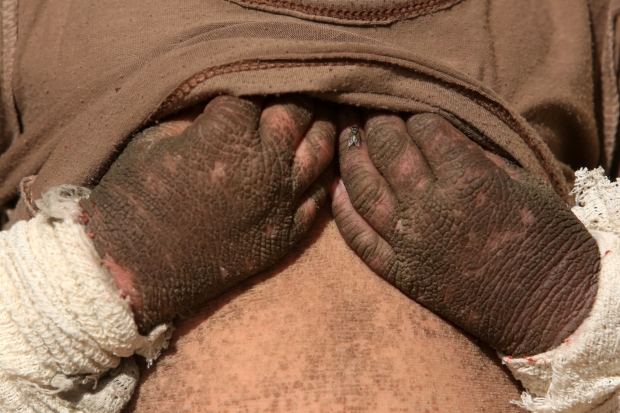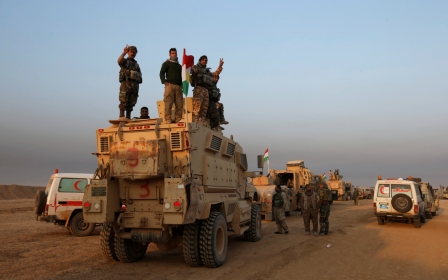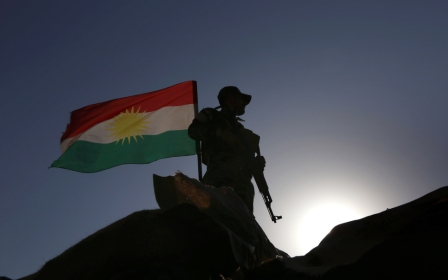Islamic State victims suffer as evidence of Iraq chemical attacks grows

QAYYARA, Iraq - The skin on five-year-old Doaa's legs, arms and neck is blackened and hard even weeks after the attack. She is still in severe pain and tries not to touch anything or move too much.
Doaa was playing in the courtyard when a rocket fired by Islamic State landed and exploded in the neighbour's garden, emitting a toxic gas, her father Abdallah Sultan and other residents said.
Around a month after the blast, a strong burning smell still pervades the air and stings the nose. The wall next door is black and all the plants in a small vegetable patch have died. Part of the rocket, which the families avoid touching, is left on the ground. The rest has been removed by rescue workers.
"We don't know what the substance in the warhead was. All we know is that it made Doaa break out in blisters all over her body, and she's not got better," 33-year-old Sultan said.
She was a victim of what appears to have been the fourth chemical weapons attack launched by Islamic State during September and October against civilians in the town of Qayyara in northern Iraq. Rights workers have so far documented at least three others.
The United Nations says Islamic State is stockpiling ammonia and sulphur in civilian areas and fears it intends to carry out more chemical attacks as Iraqi forces, backed by U.S. air power, battle the jihadists in an effort to drive them out of Mosul, their last major stronghold in Iraq.
The ultra-hardline group has shown its willingness to use toxic substances and to repeatedly target civilians, lashing out at populations in areas under its control as it has retreated towards Mosul.
The attacks on Qayyara, some 50km south of Mosul, took place just before the current offensive began in earnest on 17 OctOBER. Qayyara was recaptured from Islamic State in August but the militants were still in the area until last month.
Around the corner from where Doaa was hit, another chemical warhead landed inside a home in September, burrowing into the lawn.
The victims and witnesses said the substance used in that and all the other attacks was mustard gas.
Sirhan Awwad, in his 20s and who was injured trying to help remove the rocket, had to go to Baghdad for treatment because staff at the local clinic said they could not treat that type of burn.
"I went to bed that night and a few hours later my arms went red. The next day, I started to get blisters," he said, wearing a surgical mask at the spot where the rocket landed. His arms were still covered in blistered skin.
'No normal attack'
Awwad's brother filmed the immediate aftermath. He showed footage on his laptop of the tail of the rocket protruding from the earth, and a pool of water from a damaged underground pipe. The water had turned yellow and was bubbling.
Police removed the rocket and filled the hole with earth. Plants and trees in the yard were singed and dead.
Awwad said doctors in Baghdad had identified his symptoms as consistent with those from exposure to mustard gas agents.
Human Rights Watch on Friday reported that attack and two other uses of chemical weapons by Islamic State in Qayyara.
The New York-based watchdog cited experts as saying that blister agents such as sulphur mustard might have been the chemicals that were used.
Islamic State also set ablaze a sulphur plant outside the town as they withdrew from the area during fighting against Iraqi forces last month, US officials said, and hundreds of people were treated for breathing problems.
UN human rights office spokeswoman Ravina Shamdasani said on Friday there were reports of people dying from the fumes after that incident.
Qayyara, a town that suffered under Islamic State, still reels from the aftermath of the fight to drive out the militants.
On the street where Sultan and Doaa are staying with relatives - they fled from a village nearby earlier this year - buildings bear black marks from exploding mortar shells, and others are reduced to rubble and collapsed roofs.
Thick plumes of smoke from the oil fields which Islamic State militants set on fire as they withdrew in August billow into the air, turning the sky black and grey as the sunlight struggles to permeate the haze.
Shepherds herd sheep whose fur has been blackened by the smog, and a cow chews on rubbish.
Sultan's cousin Omar Khalifa called the Islamic State chemical attacks "not normal". But for people in Qayyara, it is no longer clear what normal is.
Middle East Eye propose une couverture et une analyse indépendantes et incomparables du Moyen-Orient, de l’Afrique du Nord et d’autres régions du monde. Pour en savoir plus sur la reprise de ce contenu et les frais qui s’appliquent, veuillez remplir ce formulaire [en anglais]. Pour en savoir plus sur MEE, cliquez ici [en anglais].





